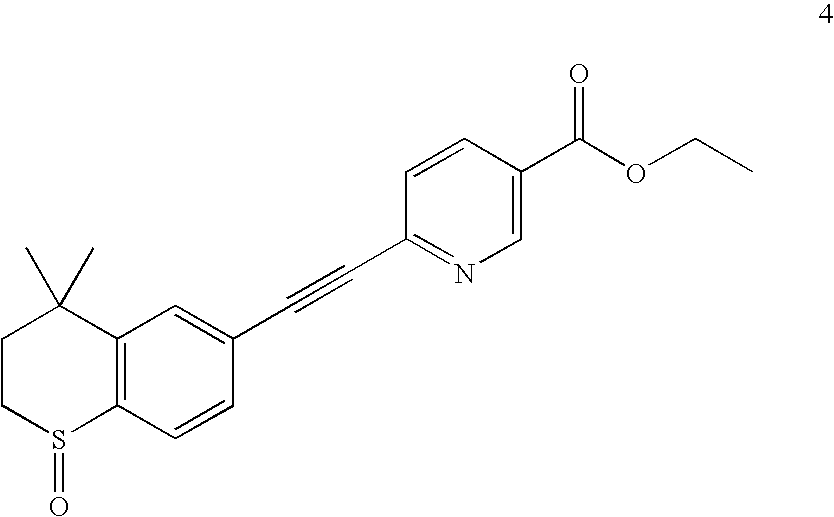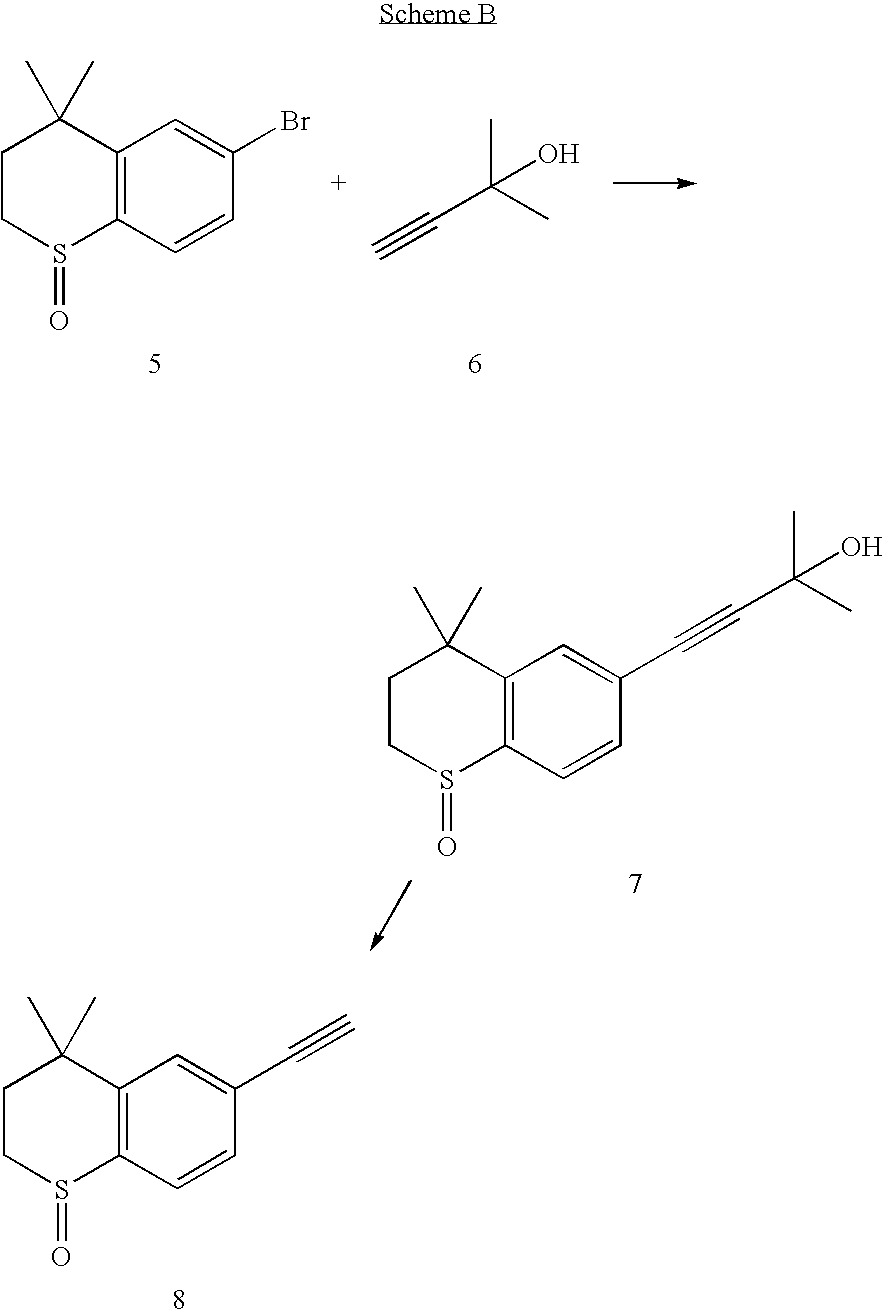Process for the preparation of Tazarotene
a technology of tazarotene and tazarotene, which is applied in the field of process for the preparation of tazarotene, can solve the problems of troublesome synthesis of (2) and failure to achieve the desired produ
- Summary
- Abstract
- Description
- Claims
- Application Information
AI Technical Summary
Benefits of technology
Problems solved by technology
Method used
Image
Examples
example 2
Preparation of 4-[(4,4-dimethyl)-thiochroman-6-yl]-2-methyl-3-butyn-2-ol-S-oxide (7)
[0023]Intermediate (5) (7.94 g, 29.0 mmol) is dissolved in dimethoxyethane (120 ml) and added in succession with water (55 ml), potassium carbonate (10.01 g, 72.45 mmol), copper(I) iodide (0.22 g, 1.16 mmol), triphenylphosphine (0.60 g, 2.32 mmol) and 10% (w / w) palladium on carbon (0.62 g, 0.58 mmol). The reaction mixture is stirred for 30 minutes at room temperature, then added with 2-methyl-3-butyn-2-ol (7.1 ml, 72.45 mmol) and heated at 80° C. for 5 hours. The reaction mixture is then cooled, filtered through Celite, diluted with water (400 ml) and extracted with ethyl acetate (2×300 ml). The organic phase is washed with water, dried over sodium sulfate, filtered and concentrated evaporated in vacuo. The resulting reaction crude is purified by column chromatography (eluent:hexane: ethyl acetate=2:1) and crystallized from hexane (15 ml) and ethyl acetate (45 ml) thereby obtaining 6.61 g of compound...
example 3
Preparation of 4,4-dimethyl-6-ethynylthiochromane-S-oxide (8) from (7)
[0024]Compound (7) (32.86 g, 119.1 mmol) is dissolved in toluene (400 ml) and added with 60% sodium hydride (400 mg, 16.7 mmol) in small portions under stirring. The reaction mixture is heated to 110° C. for 1 hour, while distilling off the toluene / acetone mixture with a Claisen adapter (200 ml). The mixture is left to cool, concentrated evaporated in vacuo, taken up with ether (400 ml) and washed with a 1M potassium carbonate solution, water and a sodium chloride saturated solution. The organic phase is dried, filtered and concentrated evaporated in vacuo thereby obtaining 21.7 g of the desired product (yield=84%; m.p.=105-107° C.). 1H NMR δ 1.32(3H, s), 1.45 (3H, s), 1.88 (1H, ddd, J=2.5, 8.8, 15.1 Hz), 2.44 (1H, ddd, J=2.5, 10.3, 15.1 Hz), 3.08 (1H, ddd, J=2.5, 8.8, 13.1 Hz), 3.17 (1H, s), 3.19 (1H, m), 7.46 (1H, dd, J=1.5, 8.1 Hz), 7.56 (1H, d, J=1.5 Hz), 7.71 (1H, d, J=8.1 Hz).
example 4
Preparation of 4,4-dimethyl-6-ethynylthiochromane (2) from (8)
[0025]Compound (8) (10.0 g, 45.87 mmol) is dissolved in N,N-dimethylformamide (150 ml), cooled to −20° C., added with phosphorous trichloride (4.0 ml, 45.87 mmol) and stirred for 1 hr, then the reaction crude is diluted with ethyl acetate (200 ml), washed with a sodium chloride saturated solution and with water. The organic phase is dried over sodium sulfate, filtered and concentrated evaporated in vacuo. The resulting solid is subjected to column chromatography (eluent:hexane / ethyl acetate=9:1) thereby obtaining 7.88 g of the desired product (yield=85%; oil). 1H NMR (250 MHz) δ 1.35 (6H, s), 1.95 (2H, m), 3.05 (2H, m), 3.15 (1H, s), 7.13 (1H, d, J=8.6 Hz), 7.58 (1H, dd, J=8.6, 2.0 Hz), 7.99 (1H, d, J=2.0 Hz).
PUM
| Property | Measurement | Unit |
|---|---|---|
| temperatures | aaaaa | aaaaa |
| temperatures | aaaaa | aaaaa |
| temperature | aaaaa | aaaaa |
Abstract
Description
Claims
Application Information
 Login to View More
Login to View More - R&D
- Intellectual Property
- Life Sciences
- Materials
- Tech Scout
- Unparalleled Data Quality
- Higher Quality Content
- 60% Fewer Hallucinations
Browse by: Latest US Patents, China's latest patents, Technical Efficacy Thesaurus, Application Domain, Technology Topic, Popular Technical Reports.
© 2025 PatSnap. All rights reserved.Legal|Privacy policy|Modern Slavery Act Transparency Statement|Sitemap|About US| Contact US: help@patsnap.com



